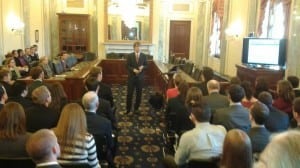CCL influencing academic work on carbon taxes
By Danny Richter
If you happened to join CCL before the release of our REMI study in June, 2014, you may remember how difficult it was to make the case for our policy based on the existing academic literature. No studies considered our policy in its entirety. The best we could hope for was cobbling together of studies that considered only parts of our policy, and make analogies about how the impact of our policy would be similar.
It was difficult. Staffers with limited time, bandwidth, and largely without much training in economics, much less the niche field of Pigouvian taxation, were not convinced by the 3-10 papers you’d need to cite to cobble together the 3-legged stool of a gradually increasing carbon fee, a 100% dividend, and a WTO-compatible border adjustment.
Then came the REMI study.
All of a sudden, we had a rigorous and credible document that not only explained all the elements of our policy, but also went further than any previous study in providing specifics on employment, GDP, international trade, carbon emissions, and premature mortality. Lobbying since this study has been, by comparison, very easy, with sincere and widespread interest in the results on both sides of the aisle.
However, trained as we are on the strength the IPCC reports draw from incorporating findings from multiple studies, CCL has never been satisfied with only the REMI study. As much as we talk it up, we have always wanted more studies. It’s just responsible inquiry.
This is why we’ve been asking members of Congress (MoCs) for Congressional Budget Office and Joint Committee on Taxation studies on the effects of our policy. We continue to try to get these, and now the cavalry is swooping in from other areas.
First, there is the excellent work done by our volunteers in Alaska. In response to a specific concern expressed by one of their MoCs, they contacted a local researcher at a local university, fund-raised to pay for a study, had the researcher present his findings directly to the MoC in question, published the study, and spoke to the media about it.
This is amazing work on many levels, but I’d like to focus on its significance from the perspective of the academic. First, recall that academics make their living under the tyranny of “Publish or Perish.” Their motivation is to publish as much as possible, in journals with the highest impact, the highest readership possible. One thing that can really kick up impact is media exposure. Another thing is providing unbiased expertise to members of Congress. So, in this situation, this academic got a study published which was shared directly with a member of Congress, then written about in the media giving him wider exposure. He even got paid. In short, things couldn’t be better for the academic.
Now consider the perspective of other academics: They will want the same sweet situation this academic found himself in. This means they are more likely to consider how our specific policy will impact residents of their specific state, because this policy has a track record of being published, and generating reputation-boosting media. This is likely to result in more studies considering our proposal, with ever more and ever clearer information on how it will affect residents of ever more states. This is very good.
It is not the only good news. At a briefing on Tuesday at Resources for the Future, three papers were presented: one considering the impact of a corporate tax swap, a payroll tax swap, and a “lump-sum rebate” (aka a dividend) across states, one considering the impact of these scenarios across income groups, and one considered exactly how a dividend might be distributed to households.
The findings, I don’t think, were anything revolutionary. Like the IPCC reports, they tell the same story as previous studies, they simply tell it with greater detail, clarity, and precision, leaving less room for doubt. For me, it will not be a question of writing new laser talks, it will be a question of updating existing laser talks.
However, it doesn’t need to be revolutionary to be highly significant. Two things stand out to me about the event, which I attended in person.
- One of the commenters, Aparna Mathur, spoke about how one of the models used to do the analysis really set a new standard for the field. Specifically, it started to look at how specific goods would be affected by a tax, and how that might feed back into the economy and affect other decisions. To me, this sounded a whole heck of a lot like what REMI already does. Is it possible, I wondered, that publishing the REMI study on this topic has challenged the field and prompted new ways of thinking about the question? We have to remember that REMI was started by academics whose work was so far ahead of their competitors at the time that they could get people to pay them to use it. They’ve had 35 years since to refine that model, all the while with people paying them so they could hire staff to help improve the model. By contrast, if you’re an academic, your entire career might be 35 years, and you certainly won’t have tens of well-paid staffers to help you out with it. It is entirely possible that the REMI model is more sophisticated than anything else out there.
- The paper investigating how exactly to distribute a dividend made reference to what might reasonably be assumed to be CCL: “Some advocates of a carbon tax pair it with a universal dividend that would divide the revenue from a carbon tax equally among all Americans” (p. 11). While the paper does not agree with our approach exactly, it nonetheless answers the question that our proposal begs: how exactly do you distribute the dividend? While a very rough outline has been found in the Administrative Costs laser talk for about 2 years now, this paper goes much, much further than that laser talk.
What’s the point here? Academics are increasingly finding CCL’s policy approach of interest to study. Why does this matter? These academics have been cited by CBO before, and they will be cited by CBO again. The more work that comes out focusing on the various aspects of our proposal and their impacts, the more likely it is that CBO will cite it. Our policy will need to have CBO look at it before it gets passed.
I opened this post by recalling just how difficult it was before the REMI study to make our case to members of Congress. The closer academics get to studying our policy, or things very like it, the more information we will have about it, and the easier it will be to convincingly make our case. It appears that CCL may be starting to have an impact on the direction of academic literature, and that is a very, very good thing.
Dr. Danny Richter is Legislative and Science Director for Citizens’ Climate Lobby.






